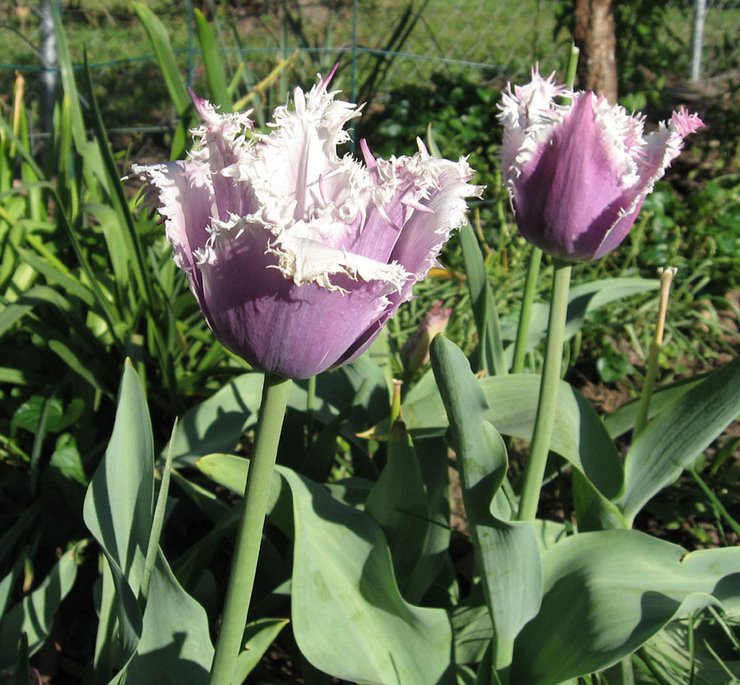Showing posts with label natural weed control. Show all posts
Showing posts with label natural weed control. Show all posts
Tuesday, May 6, 2014
Preliminary Results on New Weed-Prevention Schedule
Last year I learned more about the timing I needed to follow on applying corn gluten to my lawn to prevent weeds. So last fall I spread the gluten earlier, in August rather than in October/November; then this spring put it out earlier, in March. In previous years, my back yard in particular had lots of chickweed and henbit. This year, there was practically no chickweed, and much less henbit. It was good to see such positive results from simply tweaking the time at which I applied the corn gluten.
Friday, March 14, 2014
Time to Think of Weed Prevention
Things are beginning to green up, so I bought a bag of corn gluten today, which I plan to apply to the lawn over the weekend. I want to prevent weeds and crab grass as much as possible this year with this non-toxic method.
Saturday, September 21, 2013
War on Weeds: Sandburs
In the late summer and into early fall, one of the things my dog and I encounter on our walks is sandburs: a nasty weed with prickly burs that stick in a dog's fur, and between the pads of his feet. There are a few yards in the neighborhood that are infested with sandburs along the edges of the sidewalk. Theo gets them in his feet and stuck in the fluffy fur of his legs.
After we get back home, I have to carefully work the burs out of his hair. If I don't get them all, he pulls them out and drops them on the floor all over the house, or drops them outside in our yard, where they will try to populate my yard with the weeds.
After we get back home, I have to carefully work the burs out of his hair. If I don't get them all, he pulls them out and drops them on the floor all over the house, or drops them outside in our yard, where they will try to populate my yard with the weeds.
Thursday, September 19, 2013
War on Weeds: Climbing Milkweed Vine
Recently I noticed a vine growing up through one of my rose of Sharon bushes. It has heart-shaped leaves like those of a morning glory. It wasn't even noticeable until it grew over the top of the rose of Sharon, where it was so thick it nearly smothered my bush.
I've been pulling sections of the vine off, but yesterday I noticed that it was growing seed pods. The pods are different--a tapered shape about 4 inches long. When I opened one, the seeds had white tails that reminded me of milkweed. They also helped me identify the plant.
I've been pulling sections of the vine off, but yesterday I noticed that it was growing seed pods. The pods are different--a tapered shape about 4 inches long. When I opened one, the seeds had white tails that reminded me of milkweed. They also helped me identify the plant.
Sunday, August 25, 2013
Weed Prevention Time
Today I applied corn gluten to my yard. Corn gluten serves as a slow release high-nitrogen fertilizer, which is great for feeding your lawn; plus it prevents the germination of seeds, which keeps weeds from getting established. It doesn't kill anything that's already growing, just stops seedlings from establishing roots. Don't apply corn gluten to your lawn if you plan to overseed in the next couple of months.
Wednesday, July 31, 2013
War on Weeds: Spotted Spurge
 | |
| Spurge |
Wednesday, June 12, 2013
War on Weeds: Bindweed
 Bindweed, like the dandelion, is a deceptively pretty plant. The leaves are shaped like arrowheads, and are larger near the base than
near the ends of the stems. Flowers are trumpet shaped, and are white
or pink in color.
Bindweed, like the dandelion, is a deceptively pretty plant. The leaves are shaped like arrowheads, and are larger near the base than
near the ends of the stems. Flowers are trumpet shaped, and are white
or pink in color. Wednesday, May 15, 2013
War on Weeds: Chickweed
 | |
| Chickweed |
Monday, May 13, 2013
War on Weeds: Prickly Lettuce
 |
| Prickly lettuce (large plant in center) |
Sunday, May 5, 2013
War on Weeds: Henbit
 |
| Henbit |
Henbit prefers cool, moist soil, so it flourishes in the spring. It usually grows to about 6 inches tall. Its seeds germinate in the fall, live through the winter, and then grow and flower in the spring. As temperatures start to rise, it dies, leaves lots of seeds for fall. Henbit spreads primarily by seed, though the stems can root where they touch the soil.
Thursday, April 25, 2013
Corn Gluten
 |
| Grape hyacinths |
Subscribe to:
Posts (Atom)
Fringed Tulips



